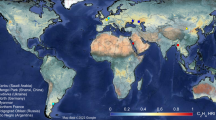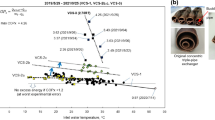Abstract
THE mechanistic pathways of reactions in an electrical discharge are of interest because of their relevance, on one hand, to reactions in primordial atmospheres1–4 and, on the other, to mass spectrometric electron impact mechanisms5–8. Although simple mixtures containing methane have been studied1–4, relatively little is known about the mechanisms of electrical discharge reactions of other organic molecules9–11. We have chosen to make a detailed examination of the products and mechanisms of the reactions of isoprene in an electrical discharge, because isoprene is a relatively simple molecule which contains loosely bound π-electrons and should be capable of forming interesting higher molecular weight products, and also because of the wide occurrence of isoprenoid units in compounds of biological importance.
This is a preview of subscription content, access via your institution
Access options
Subscribe to this journal
Receive 51 print issues and online access
$199.00 per year
only $3.90 per issue
Buy this article
- Purchase on Springer Link
- Instant access to full article PDF
Prices may be subject to local taxes which are calculated during checkout
Similar content being viewed by others
References
Ponnamperuma, C., and Woeller, F., Nature, 203, 272 (1964).
Miller, S. L., and Urey, H. C., Science, 130, 245 (1959).
Oró, J., Nature, 197, 862 (1963).
Palm, C., and Calvin, M., J. Amer. Chem. Soc., 84, 2115 (1962); Ponnamperuma, C., Lemmon, R. M., Mariner, R., and Calvin, M., Proc. U.S. Nat. Acad. Sci., 49, 737 (1963).
Weininger, S. J., Vu, Thi Mai, and Thornton, E. R., J. Amer. Chem. Soc., 86, 3732 (1964).
McLafferty, F. W., edit. by, Mass Spectrometry of Organic Ions (Academic Press, New York and London, 1963).
Budzikiewicz, H., Djerassi, C., and Williams, D. H., Interpretation of Mass Spectra of Organic Compounds; Structure Elucidation of Natural Products by Mass Spectrometry, 1, and 2 (Holden-Day, Inc., San Francisco, 1964).
Biemann, K., Mass Spectrometry, Organic Chemical Applications (McGraw-Hill Book Company, Inc., New York, 1962).
Glockler, G., and Lind, S. C., The Electrochemistry of Gases and Other Dielectrics (John Wiley and Sons, Inc., New York, 1939).
Streitwieser, jun., A., and Ward, H. R., J. Amer. Chem. Soc., 85, 539 (1963).
Streitwieser, jun., A., and Bittman, R., Abstracts of Papers, 17S, 148th meeting, Amer. Chem. Soc., September, 1964.
Cheun, L.-f., work in progress.
Author information
Authors and Affiliations
Rights and permissions
About this article
Cite this article
CALLISTER, J., THORNTON, E. Electrical Discharge Mechanisms. Isoprene and Isoprene-d4. Nature 206, 504–505 (1965). https://doi.org/10.1038/206504a0
Issue Date:
DOI: https://doi.org/10.1038/206504a0
Comments
By submitting a comment you agree to abide by our Terms and Community Guidelines. If you find something abusive or that does not comply with our terms or guidelines please flag it as inappropriate.



